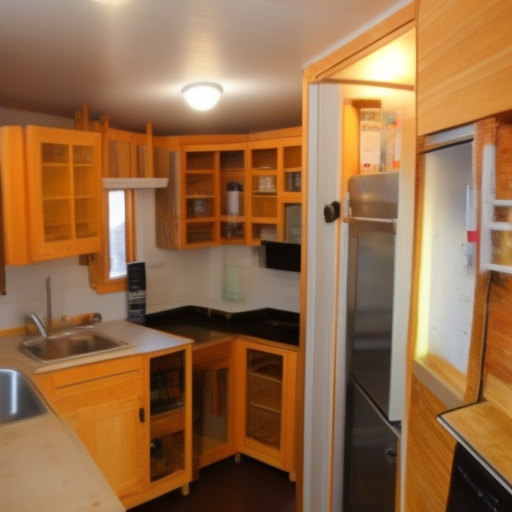Have you ever dreamed of living in the freedom of a tiny home? Maybe you’ve imagined all the fun and adventure you could have with such a compact lifestyle. But while designing the perfect tiny house is a delight, you may be unsure of what size your kitchen should be. Here, we explore the different options available and provide insight into the making the perfect tiny house kitchen.
What Is a Tiny House Kitchen?
When you think of a kitchen, you probably picture a spacious area with plenty of counter space and multiple appliances. But in a tiny house, the kitchen is anything but spacious. It’s a compact area that needs to be both functional and practical. A tiny house kitchen typically ranges from 36 to 100 square feet, and every inch counts.
To give you an idea of the limited space, imagine a kitchen that’s smaller than a single car garage. In this tiny kitchen, you’ll need to be creative with your storage solutions and only have the essential appliances to make your meals. You might have a small refrigerator, a compact stove or even a portable dishwasher that you can store away when not in use. But don’t worry, even with the limited space, your tiny house kitchen can still be beautiful and functional!
Here are some essential components of a tiny house kitchen:
– A sink (typically a small one or a sink with cutting boards that can be removed when not in use)
– A cooktop (either gas or electric)
– A compact refrigerator
– Compact appliances (such as a toaster oven or a small microwave)
– Storage solutions (such as open shelving or pull-out cabinets)
In a tiny house kitchen, every inch counts, and it’s important to maximize your space while keeping your kitchen functional. With some creativity and planning, you’ll be able to cook and entertain in your tiny kitchen like a pro!
Benefits of a Tiny House Kitchen
Living in a tiny house requires you to downsize in many aspects of your life, and the kitchen is no exception. However, having a smaller kitchen does not necessarily mean sacrificing functionality or style. In fact, a tiny house kitchen can have numerous benefits that make it a desirable feature for those looking to live more intentionally and sustainably.
One of the main is that it forces you to simplify your cooking and eating habits. With limited space, you can’t accumulate a lot of kitchen gadgets, appliances, or excess food, which can prevent waste and encourage you to cook and eat more mindfully. Additionally, a smaller kitchen often means everything is within arm’s reach, making meal prep more efficient and reducing the need to constantly move around. You’ll also save money on groceries since you won’t have the space to store and hoard unnecessary items. Lastly, having a tiny kitchen can inspire creativity and challenge you to find new ways to cook and utilize your space – for example, by incorporating vertical storage or repurposing a piece of furniture as a kitchen island.
Design Principles of Tiny House Kitchens
When designing a tiny house kitchen, there are a few key principles to keep in mind. First and foremost: functionality. You’ll need to maximize every inch of space and make sure everything has a purpose. For example, opting for a compact refrigerator with a smaller freezer or forgoing a traditional oven in favor of a countertop convection oven.
Another important design principle is storage. In a tiny kitchen, you’ll want to utilize every nook and cranny for storage. This means incorporating things like under-cabinet hooks for hanging pots and pans, magnetic knife strips, and pull-out cabinets for easy access. And don’t forget about utilizing vertical space! You can mount shelving on the walls or even consider a hanging pot rack. Ultimately, the key is to keep things organized and easily accessible to minimize clutter and maximize functionality.
Essential Features of Tiny House Kitchens
When it comes to designing a tiny house kitchen, it’s essential to maximize every square inch of space. This means selecting the right appliances and storage solutions to suit your needs. Here are some essential features that you should consider when designing your tiny house kitchen.
– Compact appliances: Since the kitchen is often one of the smallest areas in a tiny home, it’s crucial to choose appliances that can fit in the available space. Consider investing in compact models such as a two-burner cooktop, a small refrigerator, and a countertop microwave. For instance, the GE Spacemaker microwave oven is an excellent option for tiny house living, as it mounts under the cabinets to conserve valuable counter space.
– Efficient storage: In a tiny house kitchen, smart storage solutions can make a significant difference in how much you can fit into the area. Opt for cabinets and drawers with built-in organizers that allow you to maximize vertical storage. For example, pot racks can free up cabinet space, while magnetic knife strips are a great option for small kitchens since they don’t take up counter space. Remember to install open shelving to store basic items that are used daily.
Overall, with the right design and organization, a tiny house kitchen can provide all the function you need without sacrificing style. By prioritizing features like compact appliances and efficient storage, you can create a beautiful and practical kitchen that is ready for any culinary adventure. To wrap it up, the size of a tiny house kitchen will depend on a variety of factors. The DIY enthusiast or aspiring tiny home dweller should think through what their needs are and how much space they’re comfortable with when determining the ideal size for their own tiny kitchen. Whatever size you choose, you can make sure that your personal kitchen will be one of the most cherished and efficiently used areas within your own little haven-on-wheels.